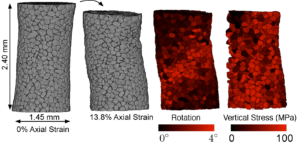Aug 2, 2023 | No Comments | By Sarah Preis
Understanding how granular materials and rocks react under stress is crucial to projects ranging from building stable roads and bridges to formulating pills and cosmetics. Soil and rock mechanics are also integral to academic fields such as civil engineering, materials science, geology, and seismology.
When granular materials experience stress, they can start to behave in a fluid-like manner. This behavior is known as plastic flow, and plasticity theories attempt to explain this and related phenomena. Although plasticity theories have been developed and used for decades, there have been no direct stress or strain measurements to validate them, in part because of the significant challenges in directly measuring stress deep within a deforming material.
Using advanced imaging techniques and a unique experimental approach, researchers at the Hopkins Extreme Materials Institute have collected data that is among the first of its kind. Ryan Hurley, assistant professor of mechanical engineering in the Whiting School of Engineering, leads a research group studying the mechanical behavior and failure mechanisms of various geomaterials. Hurley and his collaborators (including mechanical engineering doctoral students Brett Kuwik and Kwangmin Lee and former HEMI postdoctoral fellow Ghassan Shahin) have recently had their findings published in Proceedings of the National Academy of Sciences.
During this study, the team performed triaxial compression tests on synthetic quartz sands, with x-ray imaging and diffraction offering some of the first known in-situ grain stress and local strain measurements.
Using a specialized triaxial compression instrument developed in Hurley’s lab, the researchers placed quartz sand samples under confining pressures between 20 and 35 MPa—2900 to 5000 pounds per square inch (PSI)—and analyzed them using synchrotron x-ray tomography and 3D x-ray diffraction at the Advanced Photon Source at Argonne National Laboratory.
“Results from this study provide the first direct confirmation of some of the fundamental postulates we use when studying the plastic deformation of sands,” said Hurley. “On the other hand, our results contradict prior assumptions such as the existence of ‘dead zones’ outside of regions of localized straining, indicating that some fundamental ideas about plastic flow in granular materials may need to be revisited.”
The team says these findings provide an opportunity for scientists to begin evaluating certain assumptions about how granular materials such as sand respond to stress, re-evaluate old ideas, and validate and expand upon existing models in soil and rock mechanics.

3D x-ray images of sand before and after axial straining, along with renderings of the sample. Sand particles are colored by their motion (instantaneous rotations) and stress. See Hurley’s paper in this edition of PNAS for additional details.







Leave a Reply
You must be logged in to post a comment.